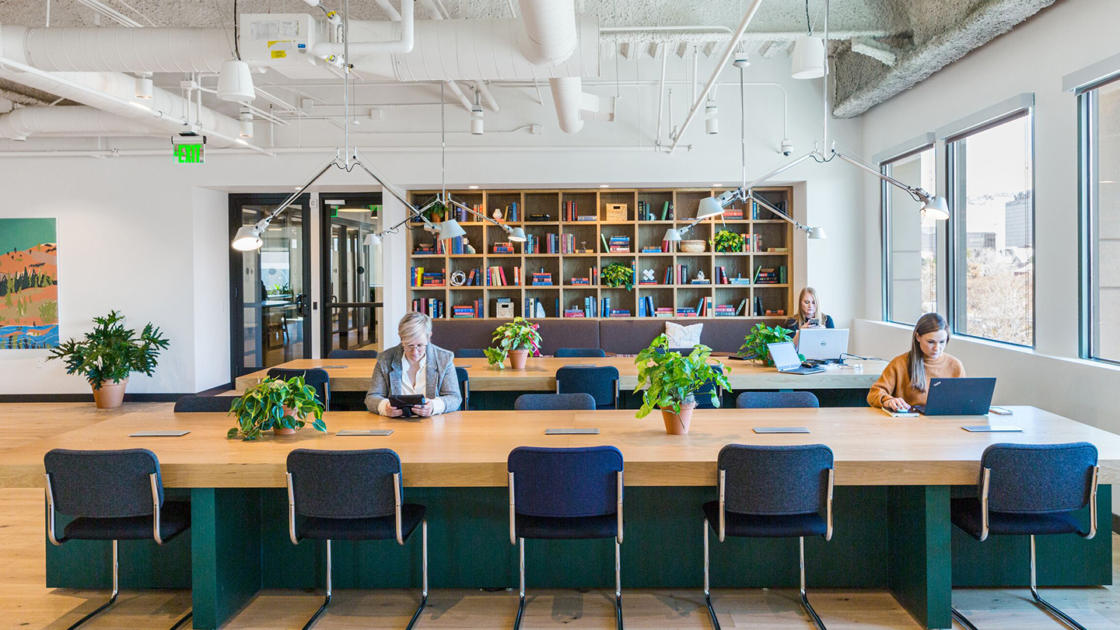A hot desk office is a modern workplace where employees do not have their own dedicated desks. Instead, they share a common workspace and move around the office throughout the day. This type of arrangement is becoming increasingly popular as businesses strive to create more flexible and collaborative workplaces.
There are several benefits of hot desking, including increased flexibility, reduced costs, and enhanced creativity and collaboration.
If you’re looking for more flexible and affordable office space, a hot desk office might be the right option for you. With a hot desk office, you can choose from a variety of different workspace options, including private offices, shared desks, and coworking spaces. And because you’re not locked into a long-term lease, you can easily scale up or down as your business needs change.

Credit: www.condecosoftware.com
What is a Hot Desk in an Office?
A hot desk is a workstation in an office that is not assigned to a specific employee and can be used by any employee who needs it. Hot desks can help reduce office costs by eliminating the need for individual desks and chairs for each employee. It also allows employees to share resources and space, which can improve collaboration.
Is Hot Desking a Good Idea?
There’s no one-size-fits-all answer to this question, as the appropriateness of hot desking depends on the specific workplace and employees involved. However, there are some general pros and cons of hot desking that can help you decide whether it’s right for your organization. Pros of hot desking include:
1. Increased flexibility and collaboration: Hot desking can make it easier for employees to collaborate, as they’re not tied to a particular desk or workstation. This increased flexibility can also lead to greater innovation, as people are more likely to interact with others from different departments when they’re not confined to their own areas.
2. Cost savings: Hot desking can save your organization money by reducing the need for dedicated workspaces and office furniture.
If you have a large office, this could be significant cost savings.
3. Reduced environmental impact: Hot desking can reduce your organization’s environmental footprint by decreasing the amount of energy used for heating, cooling, and lighting empty desks. It can also promote recycling and reuse, as employees are less likely to accumulate personal belongings at their desks when they don’t have an assigned space.
Cons of hot desking include
1. Less privacy: Hot desks generally mean less privacy for employees, as they may have to share workstations with others or store their belongings in common areas instead of individual desks or cubicles. This lack of privacy could lead to decreased productivity if employees feel like they constantly have to watch what they say or do while at work.
Additionally, it could create tension among coworkers if some people feel like they have more “privileged” spaces than others (e..g., those near windows).
Why is It Called Hot Desk?
If you’ve ever worked in an office, chances are you’ve come across the term “hot desking.” But what is hot desking? And why is it called that?
Simply put, hot desking is a way of working in which employees do not have their own assigned desks or workspaces. Instead, they can choose to sit anywhere in the office that they want on any given day. The name “hot desking” comes from the fact that desktops are often left empty and unused for much of the day.
By allowing employees to use any open desk, companies can make better use of their office space and save money on things like furniture and rent. Hot desking can also promote collaboration and creativity, as it encourages workers to mix and mingle with colleagues they might not otherwise interact with. And since there’s no need to claim or protect a personal workspace, hot-desking arrangements can help reduce workplace conflict.
What are the Hot Seats in Office?
The hot seats in the office are the positions that are most likely to be cut during a downsizing. These positions are typically in lower-level management or support roles. The hot seats can also be referred to as the “first in, first out” positions.
Hot-Desking: Is it the New Future of the Workplace?
Hot Desk Office Meaning
A hot desk is an office that is not assigned to any specific employee, and which can be used by anyone on a first-come, first-served basis. The term “hot desking” is thought to have been coined in the UK in the 1990s when companies began adopting flexible working arrangements as a way to save money on office space. The main advantage of hot desking for employers is that it can help to reduce costs associated with running an office.
For example, if you have more employees than you have desks, then you can save money by only having to provide enough desks for the number of people who are actually using them at any given time. Hot desking can also lead to increased flexibility and collaboration within an organization, as people are not tied to one particular desk or workstation. There are some disadvantages to hot desking too.
One potential issue is that it can create a feeling of insecurity among employees, who may feel like they don’t have their own space in the office. This could lead to tension and conflict between workers. Hot desking can also make it difficult for managers to keep track of where their team members are located, which could make it hard to organize meetings or coordinate deadlines.
Despite these potential drawbacks, hot desking can be beneficial for both employers and employees if it’s implemented in a thoughtful and effective way. If you’re considering introducing hot desking into your workplace, there are a few things you should keep in mind:
1) Make sure everyone understands how it will work before you start: One of the keys to making hot desking successful is ensuring that everyone knows what the rules are from the outset.
Make sure your team members know where they can go to find an available desk, how long they can stay there, and what they need to do when they’re finished (e.g., clean up after themselves).
2) Encourage people to move around: To get the most out of hot desking, encourage your team members to move around throughout the day so that everyone has a chance to use different desks and workstations. This will help ensure that no one feels like they’re always stuck in the same spot.
3) Create dedicated spaces for storage: Since hot deskers don’t have their own assigned desks or cubicles, it’s important that you create dedicated storage spaces where they can keep their belongings while they’re working elsewhere in the office.
Hot Desk Office Space near Me
If you’re looking for a hot desk office space near you, there are a few things to keep in mind. First, hot desking is typically only available during business hours. So if you’re looking for an after-hours or weekend space, it’s unlikely you’ll find a hot desk option.
Second, hot desking is usually first-come, first-served. So if you have your heart set on a particular spot in the office, be sure to get there early! Finally, remember that hot desking is meant to promote collaboration and creativity, so be prepared to interact with your fellow co-workers.
Hot Desk Wework
WeWork is a co-working space that offers hot desking. Hot desking is a flexible way of working where employees can choose to work from anywhere in the building, including common areas and break rooms. This type of arrangement encourages collaboration and networking, as well as provides employees with a greater sense of freedom and flexibility.
Why Hot Desking Doesn’T Work
If you’ve ever worked in an office, chances are you’ve come across the concept of hot desking. Hot desking is the practice of sharing desks or workspaces, and it’s often promoted as a way to promote collaboration and creativity. However, there’s plenty of evidence to suggest that hot desking doesn’t actually work.
Here’s a closer look at some of the reasons why hot desking might not be right for your workplace.
One of the main problems with hot desking is that it can lead to a feeling of isolation. When you don’t have your own desk, you can feel like you’re constantly on the move and never really have a place to call your own.
This can make it difficult to build relationships with your co-workers and feel like part of the team.
Another issue with hot desking is that it can be distracting. If you’re trying to concentrate on your work but people are constantly walking by or sitting down at your desk, it can be tough to stay focused.
And if you’re someone who likes having everything neat and organized, sharing a desk can be frustrating – especially if other people aren’t as tidy as you are!
Finally, hot desking can also lead to more sick days. Since desks are shared, they’re also more likely to harbor germs and bacteria.
If someone is sick, they could easily pass those germs on to others by using the same desk – which means more people will end up taking time off work because they’re ill.
Overall, there are plenty of good reasons why hot desking might not be right for your workplace. If you value privacy, focus, and cleanliness, it might be better to stick with traditional desks rather than shared ones.
Conclusion
If you’re looking for a way to make your office more efficient and collaborative, hot desking may be the answer. Hot desking is a flexible working arrangement where employees share desks instead of each having their own. This can free up space in the office and allow employees to choose their workspace based on what suits their needs for the day.
There are a few things to keep in mind if you’re considering hot desking for your office. First, it’s important to have enough desks for all of your employees. You’ll also need to consider how you’ll handle storage and privacy concerns.
With careful planning, hot desking can be a great way to improve efficiency in your workplace.
